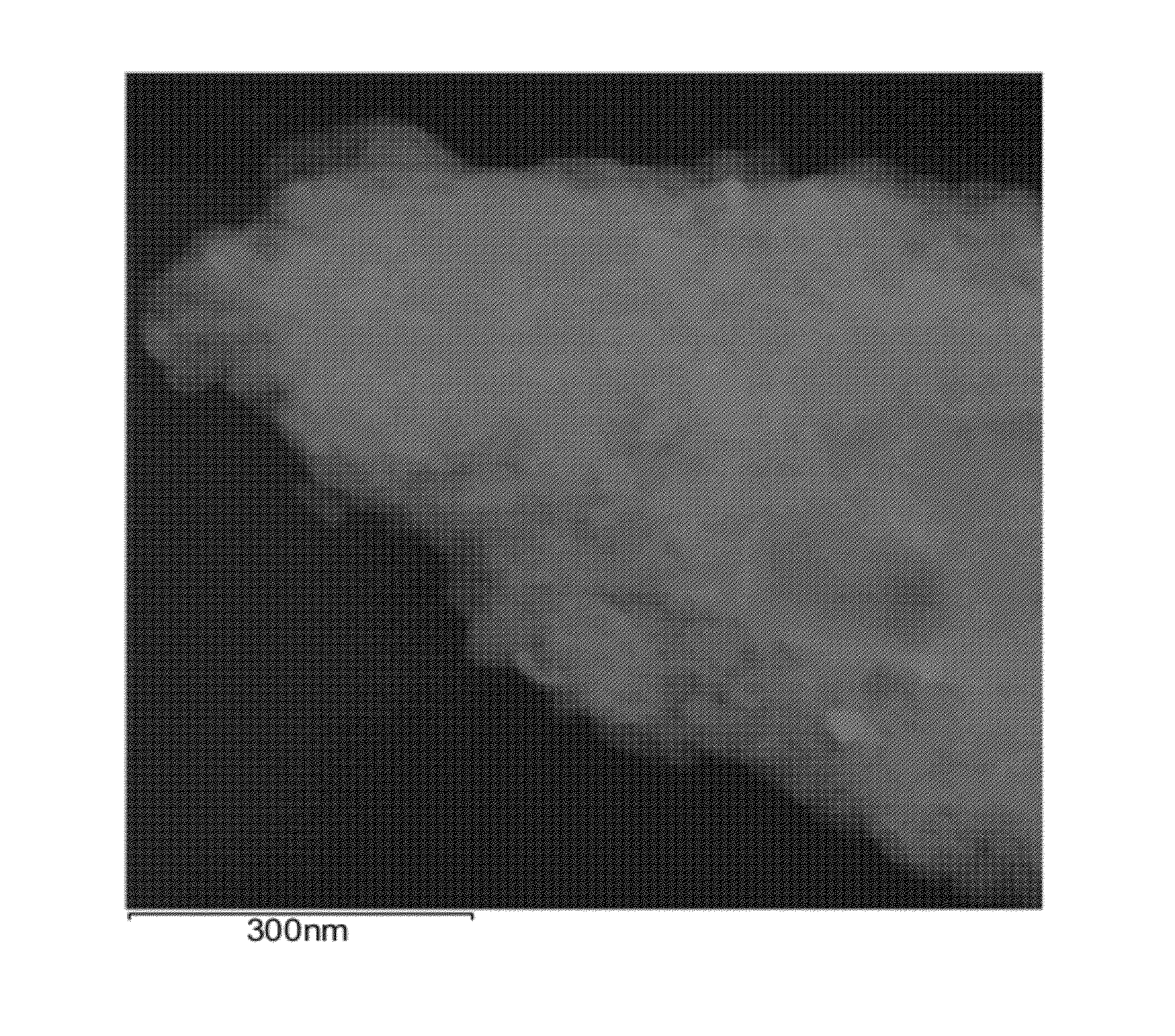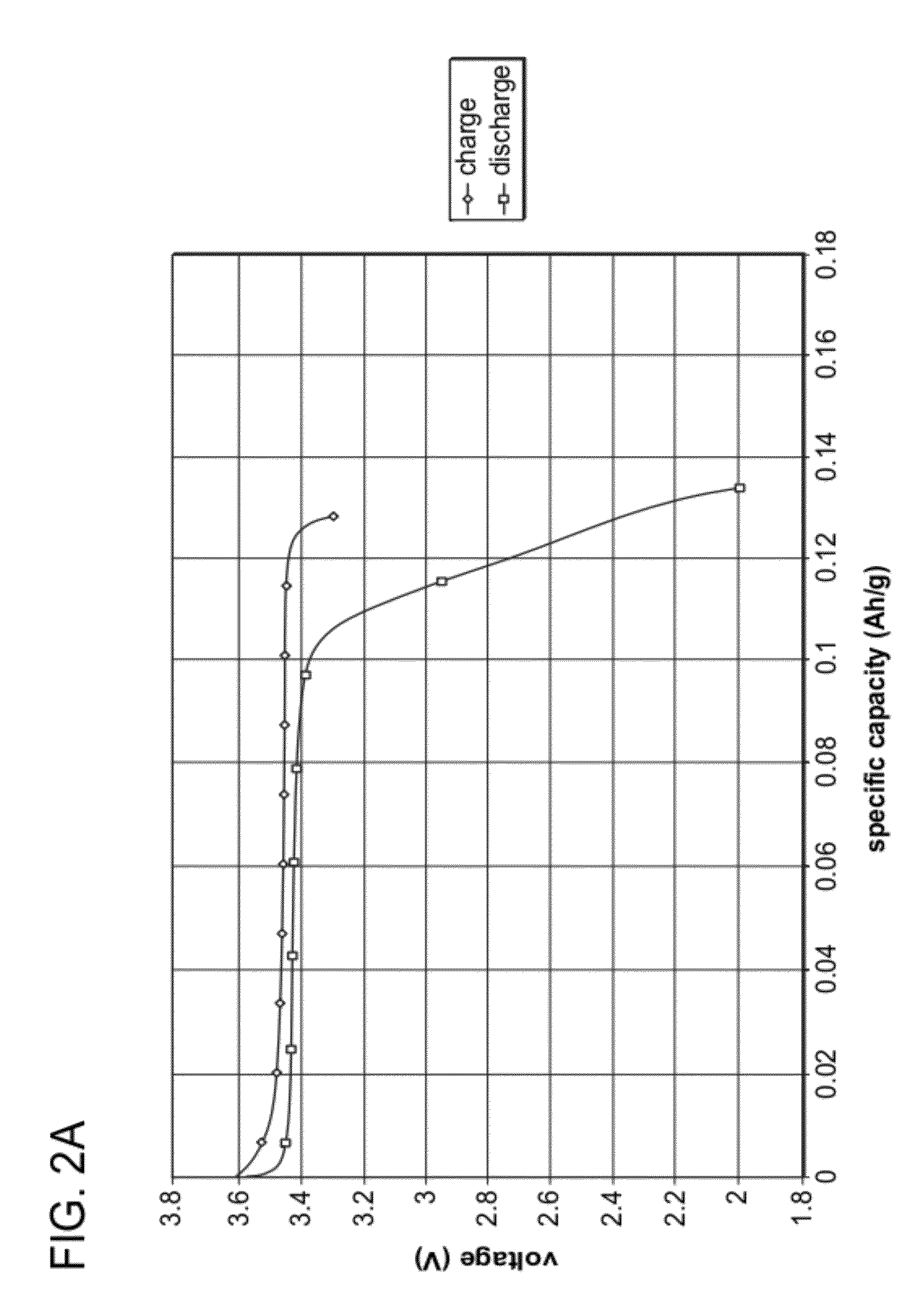Amorphous and partially amorphous nanoscale ion storage materials
a technology of nano-scale ion storage and nano-ion ion, which is applied in the direction of non-metal conductors, cell components, conductors, etc., can solve the problems of low electronic conductivity and alkali ion conductivity of storage compounds, and is less than ideal for electrochemical applications. , the range of solid solution range of many such compounds is limited
- Summary
- Abstract
- Description
- Claims
- Application Information
AI Technical Summary
Benefits of technology
Problems solved by technology
Method used
Image
Examples
example 1
[0066]Compositions of undoped Li0.90FePa4, Li1.0FePO4, and Li0.95FePO4 were prepared from the starting raw materials Li2CO3, FeC2O4.2H2O, and (NH4)H2PO4. The starting raw materials were ball-milled using steel milling balls in a polypropylene jar with ketone solvent for 72 hours, then dried. The dried material was then fired in flowing nitrogen gas atmosphere, first at 350° C. for 10 hours, then at 600° C. for 20 hours. The resultant samples were labeled A (Li0.90FePO4), B (Li1.0FePO4), and C (Li0.95FePO4). The samples were found to be nanoscale, having BET specific surface areas of 38.43, 39.48, and 33.60 m2 / g, respectively. The samples had carbon contents of 5.43%, 4.90% and 4.63%, respectively. These powders were made into Swagelok™ type lithium half-cells, and tested at low and high rates. FIG. 1 is a plot of discharge capacity at various C-rates. Each curve is an average of three cells. The results show that the materials are capable of high capacities at high rates. FIGS. 2A, ...
example 2
[0075]Two compositions, Li0.5FePO4 (sample F) and FePO4 (sample G), were prepared using the same starting materials and procedures as for the samples described in Example 1. The BET surface areas and carbon contents were 42.86 m2 / g and 22.96 m2 / g, and 4.00% and 4.68%, respectively. XRD of a 50:50 mixture by weight of Si and each sample (FIGS. 16-17) showed that the Li0.5FePO4 sample had broad olivine peaks that were still more reduced in intensity relative to the Si than the earlier described samples of higher Li content. The FePO4 sample was different still; it had no easily discernable olivine peaks, only broad peaks, which also did not match the hexagonal FePO4 phase. It is also noteworthy that none of the earlier shown XRD patterns, even those for Li deficient compositions, showed the hexagonal FePO4 phase. Thus, the results indicate that the presence of lithium promotes crystallization of the olivine phase, but not the complete crystallization of the sample, and that in the abs...
example 3
[0077]An undoped predominantly crystalline nanoscale LiFePO4 powder was prepared using the method of Example 1, with final firing being carried out at 700° C. for 5 hours. The powder was found to have a BET specific surface area of 39.8 m2 / g, corresponding to an equivalent spherical particle size of 42 nm. Transmission electron microscopy (“TEM”) showed the powder particles to be equiaxed, and TEM images and Rietveld refinement of X-ray diffraction data showed a crystallite size very similar to that inferred from the BET measurement.
[0078]The powder was formulated into electrodes and tested in Swagelok™ type cells of the type described in Example 1. The assembled cell was charged and discharged for one full cycle at C / 5 rate to determine the electrode capacity, and then charged to 50% state-of-charge (SOC) at a C / 10 rate. The cell was disassembled immediately, 0.5 mg of Si powder was placed on the surface of the electrode as a peak calibration standard, and X-ray diffraction was con...
PUM
| Property | Measurement | Unit |
|---|---|---|
| specific surface area | aaaaa | aaaaa |
| dimension | aaaaa | aaaaa |
| dimension | aaaaa | aaaaa |
Abstract
Description
Claims
Application Information
 Login to View More
Login to View More - R&D
- Intellectual Property
- Life Sciences
- Materials
- Tech Scout
- Unparalleled Data Quality
- Higher Quality Content
- 60% Fewer Hallucinations
Browse by: Latest US Patents, China's latest patents, Technical Efficacy Thesaurus, Application Domain, Technology Topic, Popular Technical Reports.
© 2025 PatSnap. All rights reserved.Legal|Privacy policy|Modern Slavery Act Transparency Statement|Sitemap|About US| Contact US: help@patsnap.com



